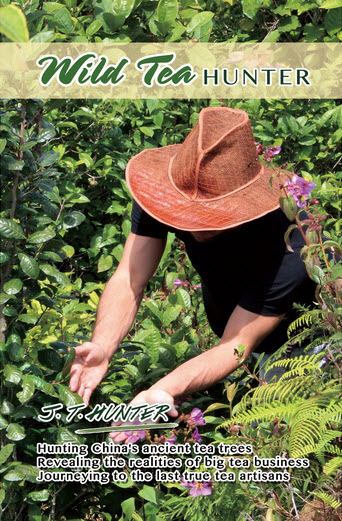Author: J.T. Hunter
Illustrator: Shana Zhang
The allure of China stimulates author J.T. Hunter’s sense of adventure as he takes readers off the beaten path into the major tea producing regions in search of uncultivated tea.
He writes with a sensitive appreciation of ancient Chinese tea culture. His respect for the tea growers and tea masters is drawn from his willingness to sit and listen carefully in their homes and shops where he sometimes stays for days at time — long enough to learn tea’s subtleties.
 His is a book that brings into focus not just the taste, but the experience of tea.
His is a book that brings into focus not just the taste, but the experience of tea.
He shares his knowledge in depth, introducing the characters and describing the humble villages, the mountains, forests and terrain that appear exotic in travel brochures. Yet the people he meets are quite approachable.
Take Master Yu, who introduced him to Wild Lapsang Souchong, revealing not just the taste sensations, but the reverence of a culture that prizes the feeling of tea.
“Every tea has a different Qi quality; Wild Lapsang Souchong has a rising energy. Notice how the sweet chocolate aftertaste sticks to your mouth, adding a sense of fullness… feel the energy rise through your body,” writes Hunter who describes a sensory experience that requires preparation well beyond that of tea drinkers in the West. Hunter’s lifelong study of Qigong, the ancient Taoist practice of moving energy in and around the body through breath and visualization, has readied him.
“Cleansing the internal and external body before drinking tea is a Taoist practice,” he writes. Clean your mind of thoughts by breathing deeply… repeat for a few cycles. Then wash your hands and face; follow by drinking a cup of pure hot water to cleanse the internal. Only then do you savor the tea.
“Taoist sects believe that we are constantly absorbing energy from nature. This is why Taoist monks live high in the mountains, surrounded by beautiful, wild forests with fresh air and good energetic alignment. Tea is a way to ingest energy, it helps them attain a higher level of enlightenment,” explains Hunter who uses the text to reveal his lifelong study of medicine, martial arts and religion.
While Hunter’s book shares with us the beauty of tea and its tea artisans, it is also a practical guide to the cultivation of tea and an explanation of his own efforts to organize and make these teas available to customers of www.wildteaqi.com.
His selling methods reflect what he has learned in his travels. For example, he groups his teas according their affiliation with the five elements: wood, fire, earth, metal and water. These elements are interlinked (water corrodes metal, earth snuffs out fire) and associated with the seasons as well as organs in the body. Black tea is born by fire, he writes, and shares some of fire’s characteristics and is most closely associated with the heart.
Hunter’s tea study began when he traveled to China to practice healing arts in a free clinic. Tea is integral to the practice of medicine, according to Hunter. “People in the U.S. drink tea for reasons that differ greatly from why the Chinese drink tea,” writes Hunter, who then describes the intricate connection between specific tea, the organs and the elements.
Wild Tea Qi now specializes in sourcing and sharing information about the crafting wild teas such as those of Yunnan, as well as trees in less well-known regions such as Wuchuang and Cheshui County in Guizhou province and in Sichuan province.
“The Taoists I met in Wuyishan drank Oolongs and black teas. Those in Wudangshan prefer green. The general rule is to drink teas made locally, Hunter explains.
His 152-page work reads as trekking adventure at times, with chapters devoted to the discovery of teas like those used to make Purple Puer, a much prized tea from Yunnan that sells for $8 a gram. Along the way he experiences the ethnic minorities of the region including the Wa, Hani and Yi tribes all in his successful pursuit of legendary trees centuries old.
His travels raised his awareness of damage to the ecosystem and the need for sustainable practices. He issues a call to action for consumers to create a ripple that can become a big wave as the tea industry gets bigger and bigger.
To those who ask “what can I do?” Hunter advises that consumers should become informed about where tea is sourced. “Buy tea that is sustainably harvested from trees that grow naturally in an undisturbed environment,” writes Hunter. He favors gardens that integrate with the local ecology and wildlife. In such places, flowers such as orchids grown naturally around and on the tea trees, adding an incredible flavor to the tea, he writes.
“What started as an adventure of discovery of beautifully rich tea cultures changed my life,” said Hunter. The artisans that grow tea in bio-diverse plantations make better tea, he said. Their way of life should be preserved.
“I felt a great responsibility to purchase their teas in order to support them,” he said, “even though I loved some teas from destructive plantations, my conscience would not allow me to buy them.”
“My adventures continue. I hope readers will share my message of hope in support of conscious tea drinking: Our beautiful planet and a rich tea cultivation tea culture is what is at stake here,” he said.
— Dan Bolton is the editor of Tea Biz.
Format: Kindle Edition
File Size: 2054 KB
Publisher: Wild Tea Qi Publishing (May 28, 2013)
Price: $8.99
Sold by: Amazon


